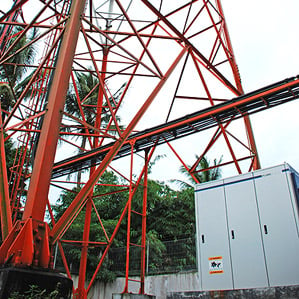Years in the Making, Promising Rechargeable Metal-Air Batteries Head to Market
After years of development, a novel battery technology from the startup Fluidic Energy is being commercialized (see “Betting on a Metal-Air Battery Breakthrough”). It’s a rechargeable metal-air battery whose first application is replacing diesel and lead-acid battery backup systems for telecommunications towers, and for other businesses that need a steady supply of power. The company has been quietly demonstrating its battery with customers for a year. In an interview with MIT Technology Review, Fluidic Energy founder and chief technology officer Cody Friesen made details about its product publicly available for the first time.

Metal-air batteries have the potential to store more energy than lithium-ion batteries, which are now used in electric vehicles and some grid applications. Based on the materials used, metal-air batteries could also be less expensive than lead-acid batteries, the cheapest, widely used rechargeable batteries.
But while nonrechargeable metal-air batteries have been used commercially for a long time—they’re often used in hearing aids, for example—it’s been difficult to make them rechargeable. In a metal-air battery, a metal such as zinc (the one used in the case of Fluidic Energy) reacts with oxygen from the air to generate electricity.
To repeatedly recharge a metal-air battery, it’s necessary to remove that oxygen and form zinc metal again. But the metallic zinc left behind tends to form porous structures that take up much more space than dense, solid metal, negating the potential size advantage of metal-air batteries. Upon recharging, the zinc can also form root-like structures that cause short circuits within the battery. Making a long-lasting air electrode—the site of the interaction between the battery and the outside environment—is also a challenge. The existing ones are fine for single-use batteries, but not for rechargeable batteries that are meant to last longer.
To address the problem of zinc producing bulky, dendritic structures, Fluidic Energy uses chemical additives to ensure that zinc forms dense, uniform layers. The problem is that these additives tend to evaporate or break down over time. Fluidic Energy developed proprietary ionic liquids that don’t evaporate and don’t decompose at the voltages seen in the battery, and that, crucially, are inexpensive. The high cost of ionic liquids has kept them from being used in battery applications.
Friesen says the company also developed air electrodes that last five to seven times longer than others on the market, although he’s keeping the specific advances that made that possible secret.
The resulting batteries are cheaper than buying the combination of lead-acid batteries and diesel engines typically used to keep telecommunication towers running through blackouts. And they cost far less to operate, since they eliminate the need for diesel fuel, at least when the telecommunication towers are connected to the grid. (The batteries can also be used in off-grid applications, where they’d need to be paired with a power source such as solar panels or a diesel generator.)
While the batteries seem to be a good solution for telecommunication towers, it could be a while before the batteries are used in cars. Metal-air batteries are an intriguing technology for cars because they have the potential to store three or four times as much electricity as lithium-ion ones, which could extend vehicle range or make it possible to use smaller, cheaper battery packs. “We’re not anywhere close to that,” Friesen says, although the technology stores significantly more energy than lead-acid batteries.
Large-scale grid storage could also be a challenge. Historically, efficiency has been a problem with metal-air batteries, which can waste nearly half the energy stored in them. Friesen says Fluidic has addressed the problem, but for competitive reasons he wouldn’t give the specific efficiency, other than to say that “our efficiencies are far beyond that of a diesel and lead-acid system.”
In addressing the backup power market, Fluidic Energy will face a tough competitor. GE recently opened a large factory in Schenectady, New York, to build batteries that are also designed to replace diesel generators and lead-acid batteries (see “GE’s Novel Battery to Bolster the Grid” and “Inside GE’s New Battery Factory”).
Keep Reading
Most Popular
Large language models can do jaw-dropping things. But nobody knows exactly why.
And that's a problem. Figuring it out is one of the biggest scientific puzzles of our time and a crucial step towards controlling more powerful future models.
The problem with plug-in hybrids? Their drivers.
Plug-in hybrids are often sold as a transition to EVs, but new data from Europe shows we’re still underestimating the emissions they produce.
Google DeepMind’s new generative model makes Super Mario–like games from scratch
Genie learns how to control games by watching hours and hours of video. It could help train next-gen robots too.
How scientists traced a mysterious covid case back to six toilets
When wastewater surveillance turns into a hunt for a single infected individual, the ethics get tricky.
Stay connected
Get the latest updates from
MIT Technology Review
Discover special offers, top stories, upcoming events, and more.